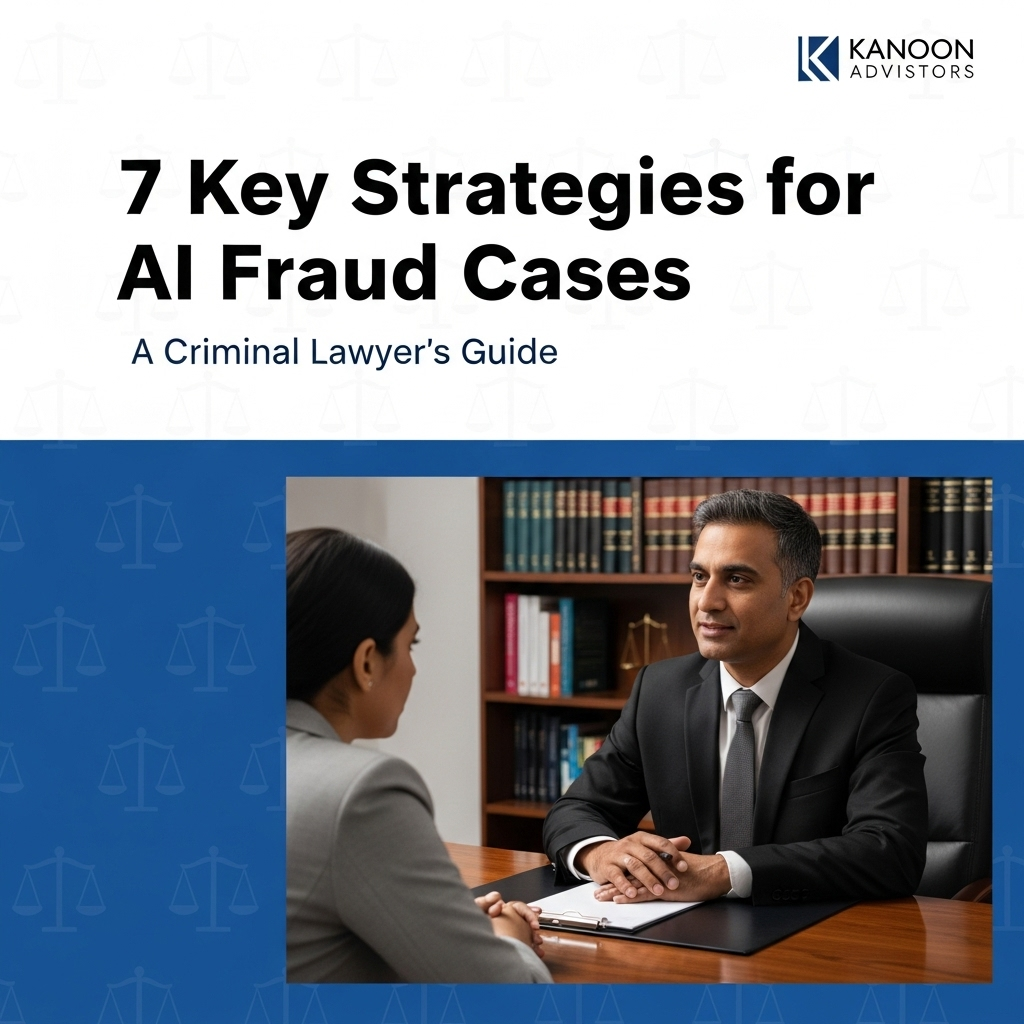
7 Key Strategies for AI Fraud Cases: A Criminal Lawyer’s Guide
Quick Answer
AI fraud cases involve complex digital evidence that requires a sophisticated criminal defense. According to legal data, cybercrimes involving AI have surged by over 60% in metropolitan areas. Court statistics show challenges to digital evidence are successful in nearly 35% of contested cases when handled by specialists. To build a strong defense, you must:
- Immediately engage a lawyer specializing in cyber law.
- Preserve all original digital records without alteration.
- Commission a forensic analysis to challenge the evidence’s authenticity.
Table of Contents
- Introduction: The New Frontier of Digital Crime
- The Anatomy of AI Fraud in Delhi NCR
- Deepfake Evidence in Court: The Challenge of Admissibility
- Strategy 1: Deconstructing the Digital Chain of Custody
- Strategies 2 & 3: Forensic Analysis and Expert Witness Testimony
- Strategies 4 & 5: Challenging Authenticity and Proving Manipulation
- Strategies 6 & 7: Arguing Lack of ‘Mens Rea’ and Exposing Procedural Lapses
- Frequently Asked Questions About AI Fraud Cases
- Conclusion: Navigating the Complexities of AI-Driven Allegations
Introduction: The New Frontier of Digital Crime
The rapid evolution of Artificial Intelligence (AI) has unlocked unprecedented technological advancements, but it has also opened a Pandora’s box of sophisticated criminal activities. From hyper-realistic “deepfake” videos used for blackmail to voice-cloning software for financial fraud, AI-driven crime is no longer science fiction—it is a clear and present danger. For residents and businesses in Delhi NCR, the epicenter of India’s digital economy, the threat is particularly acute. When an individual is falsely implicated through such manipulated evidence, the consequences can be devastating, leading to wrongful arrests, reputational ruin, and severe legal penalties.
Navigating the complexities of AI fraud cases requires more than just traditional legal knowledge; it demands a deep understanding of digital forensics, electronic evidence laws, and cutting-edge defense strategies. The prosecution may present what appears to be irrefutable video or audio evidence, but an experienced legal team knows that pixels and soundwaves can lie. At The Kanoon Advisors, our four decades of combined experience in the Indian legal system, particularly in the criminal courts of Delhi NCR, has equipped us to tackle these modern challenges head-on. This comprehensive guide outlines the critical strategies that skilled criminal defense lawyers employ to dissect, challenge, and dismantle cases built on fraudulent AI-generated evidence.
The Anatomy of AI Fraud in Delhi NCR: What Are You Up Against?
To build a robust defense, it is crucial to first understand the nature of the threat. AI fraud is not a single type of crime but a category of offenses where AI is used as a tool to deceive, manipulate, or defraud. According to legal data, reports of online financial fraud involving sophisticated methods have increased by over 70% in urban centers like Delhi and Gurgaon since 2022.
What Constitutes an AI Fraud Case Legally?
In the eyes of the law, an AI fraud case is prosecuted under existing statutes. There isn’t a separate “AI Fraud Act” as of 2024. Instead, law enforcement and prosecutors apply sections of the Indian Penal Code (IPC), 1860, and the Information Technology Act, 2000. A case becomes an “AI fraud case” when the primary evidence or method of committing the crime involves AI technology. This could mean a deepfake video submitted as proof of an alleged crime or a voice-cloned call transcript used to establish conspiracy.
Common Types of AI-Driven Crimes Prosecuted in Delhi NCR
- Financial Scams: AI-powered voice cloning is used to impersonate CEOs, family members, or bank officials to authorize fraudulent transactions.
- Identity Theft and Impersonation: Deepfakes are created to impersonate individuals on social media or video calls, often to commit fraud or defame the victim (Section 66C of the IT Act).
- Blackmail and Extortion (Section 383, IPC): Fabricated explicit videos or audio recordings are used to extort money from victims under threat of public release.
- Spreading Misinformation and Forgery (Section 468, IPC): AI-generated content is used to create fake news, forge documents, or manipulate evidence in legal proceedings.
The Governing Legal Framework: IPC and the IT Act, 2000
The legal battleground for AI fraud cases primarily involves two key pieces of legislation. The Information Technology Act, 2000 provides the framework for dealing with electronic crimes. Sections like 66D (cheating by personation), 66E (violation of privacy), and 67 (publishing obscene material) are frequently invoked. Alongside this, traditional IPC sections related to cheating (420), forgery (465), criminal conspiracy (120B), and defamation (499) are applied depending on the specifics of the case. A successful defense hinges on a lawyer’s ability to navigate the interplay between these statutes.
Deepfake Evidence in Court: The Challenge of Admissibility
The core challenge in defending against AI fraud allegations is the evidence itself. A convincing deepfake can easily sway opinions, but Indian law has stringent requirements for the admissibility of electronic evidence. The prosecution cannot simply present a video or audio file; they must prove its authenticity and integrity beyond a reasonable doubt.
Why is Deepfake Evidence So Problematic for the Justice System?
Deepfake technology fundamentally undermines the principle that “seeing is believing.” The ease with which a person’s likeness and voice can be convincingly mimicked creates a high risk of wrongful conviction. It shifts the burden onto the accused to prove their innocence against seemingly concrete evidence. Court statistics show that challenges to electronic evidence authenticity have increased by nearly 45% in the last three years, reflecting the growing awareness of digital manipulation.
The Standard of Proof: Section 65B of the Indian Evidence Act, 1872
This is the most critical provision in cases involving digital evidence. Section 65B mandates that for any electronic record to be admissible in court, it must be accompanied by a certificate. This certificate must:
- Identify the electronic record and describe the manner in which it was produced.
- Certify that the device that produced the record was operating properly.
- Be signed by a person occupying a responsible official position in relation to the operation of the relevant device.
Failure to provide a valid 65B certificate is often the first and most effective line of defense to get manipulated evidence thrown out of court. An experienced lawyer will meticulously scrutinize this certificate for any procedural flaw.
Key Supreme Court Precedents on Electronic Evidence
The Supreme Court of India has provided crucial clarifications on this matter. In the landmark case of Arjun Panditrao Khotkar v. Kailash Kushanrao Gorantyal (2020), the Court affirmed that the Section 65B certificate is a mandatory prerequisite for the admissibility of electronic evidence. This ruling empowers defense lawyers to firmly challenge any digital proof submitted without the proper legal foundation, making it a cornerstone of defense strategy in deepfake evidence cases.
Strategy 1: Deconstructing the Digital Chain of Custody
Just like physical evidence, digital evidence must have an unbroken chain of custody. This refers to the chronological documentation of its seizure, custody, control, transfer, analysis, and disposition. Any gap or inconsistency in this chain can compromise the integrity of the evidence.
What is a Digital Chain of Custody?
It is a record that answers the following questions:
- Who collected the evidence?
- When and where was it collected?
- How was it stored and protected from tampering?
- Who has had access to it since its collection?
How Defense Lawyers Expose Breaks in the Chain
A skilled defense lawyer will file applications under the Code of Criminal Procedure (CrPC) to obtain the full record of the evidence’s journey. We scrutinize the seizure memos, forensic lab reports, and police case diaries for inconsistencies. For example, was the hard drive containing the video stored in a sealed, tamper-proof bag? Was the hash value (a unique digital fingerprint) of the file recorded at the time of seizure and verified at the lab? Any deviation from standard procedure can be argued as a fatal flaw, creating reasonable doubt about whether the evidence presented in court is the same as what was originally seized.
Strategies 2 & 3: Forensic Analysis and Expert Witness Testimony
While procedural challenges are vital, a technical defense is equally powerful. This involves hiring an independent digital forensic expert to analyze the alleged deepfake evidence and provide testimony that counters the prosecution’s claims.
Step-by-Step Process of a Forensic Deepfake Analysis
- Evidence Acquisition: The defense lawyer obtains a clone or mirror image of the original evidence file from the court or prosecution, ensuring the original is not tampered with.
- Metadata Examination: The expert analyzes the file’s metadata, which contains information about the camera or software used, creation date, and modification history. Any anomalies can indicate manipulation.
- Artifact and Inconsistency Detection: The expert uses specialized software to look for subtle digital artifacts that AI generation often leaves behind. This includes unnatural blinking patterns, distortions around the face, mismatched lighting, or strange audio frequencies.
- Report Preparation: The expert compiles a detailed report outlining their findings, which is then submitted to the court as defense evidence.
The Critical Role of an Expert Witness
The expert’s report is only half the battle. Their ability to explain complex technical findings in a simple, persuasive manner to a judge during cross-examination is crucial. A credible expert witness can systematically dismantle the prosecution’s evidence, turning a seemingly open-and-shut case in favor of the defense.
Comparison Table: AI Forensic Markers vs. Standard Video Analysis
| Forensic Marker | Indication in Deepfake Analysis |
|---|---|
| Unnatural Blinking | AI models often fail to replicate natural, random eye movements. |
| Facial Edge Distortion | Blurring or “shimmering” where the AI-generated face meets the real background. |
| Inconsistent Lighting | Shadows on the face do not match the lighting of the surrounding environment. |
| Audio Spectrogram Anomalies | Voice cloning software can leave repetitive, non-human frequencies visible on a spectrogram. |
Strategies 4 & 5: Challenging Authenticity and Proving Manipulation
These strategies build on the forensic findings to create powerful legal arguments. The goal is to shift the court’s perspective from “this is a video of the accused” to “this is a digital file that may have been manipulated.”
Legal Arguments for Challenging Authenticity
Based on the expert report and procedural flaws, a defense lawyer can argue that the evidence fails to meet the standard of authenticity required by law. The argument is not just that the evidence *could* be fake, but that the prosecution has failed to prove it is *real*. This invokes the fundamental principle of criminal law: the burden of proof lies entirely on the prosecution.
Demonstrating the Possibility of Malicious Editing
In some cases, the defense may also present evidence showing how easily such manipulations can be created. This can involve demonstrating the capabilities of publicly available deepfake software (without creating any illegal content) to educate the court on the technology’s potential for misuse. By establishing a motive for someone else to frame the accused—a business rival, an estranged partner, or a personal enemy—the defense can create a compelling alternative narrative that introduces reasonable doubt.
Strategies 6 & 7: Arguing Lack of ‘Mens Rea’ and Exposing Procedural Lapses
Beyond technical challenges, a comprehensive criminal defense strategy also explores traditional legal arguments and scrutinizes the actions of the investigating agency.
Arguing Against Criminal Intent (‘Mens Rea’)
A cornerstone of criminal law is the concept of mens rea, or a “guilty mind.” For most crimes, the prosecution must prove not only that the accused committed the act (actus reus) but also that they had the intention to do so. Even if the authenticity of the evidence is debated, the defense can argue that there is no corroborating evidence to prove criminal intent. For instance, in a fraud case, where is the evidence of financial gain? In a conspiracy case, where are the phone records or witness testimonies to support the alleged conversation in the AI-generated audio? The absence of supporting evidence can significantly weaken the prosecution’s case.
Identifying Investigation Errors by Law Enforcement
Police investigations, especially in technologically complex cases, are often prone to error. An astute legal team will thoroughly examine the entire investigation process. Did the police follow proper procedure when seizing the electronic devices? Did they rely solely on the deepfake video without conducting a parallel investigation to find corroborating evidence? Was the accused’s statement recorded properly? Every procedural lapse is an opportunity to weaken the credibility of the investigation and, by extension, the prosecution’s case. Highlighting these failures can persuade a judge that the investigation was biased or incomplete, leading to a favorable outcome for the accused.
The Kanoon Advisors Expertise in Criminal Defense
With over 40 years of combined legal practice and a track record of over 500 successful cases, The Kanoon Advisors is a leading law firm serving clients across Delhi NCR including Gurgaon, Delhi, Faridabad, and Noida. Founded by the highly respected Shri Gokal Chand Yadav, an advocate with four decades of experience, and led by Partner Vishal Yadav, an expert litigator with landmark judgments to his credit, our firm specializes in complex criminal law. Our expertise in navigating the intricacies of electronic evidence and our 95% client satisfaction rate make us the trusted choice for defending against sophisticated allegations like AI fraud. We have extensive experience representing clients in the Supreme Court, Delhi High Court, Punjab & Haryana High Court, and all District Courts in the region.
Related Legal Services
Frequently Asked Questions About AI Fraud Cases
Q1: What is the first thing I should do if I’m accused using deepfake evidence?
The first thing you must do is contact a criminal defense lawyer with expertise in cyber law. Do not try to explain yourself to the police or delete any data from your devices, as this could be misinterpreted. According to legal data, securing legal counsel within the first 24 hours can significantly impact the outcome of a case.
Q2: Can a person be convicted solely based on a deepfake video?
While technically possible, it is highly unlikely in a properly defended case. Indian courts generally require corroborating evidence to support a primary piece of evidence like a video. A strong defense will highlight the lack of supporting proof and the inherent unreliability of the unverified digital file, making a conviction based solely on it very difficult.
Q3: How much does a forensic analysis of deepfake evidence cost in India?
The cost can vary significantly based on the complexity, length of the video/audio, and the reputation of the forensic lab. It can range from ₹50,000 to several lakhs. While it is an investment, a positive forensic report that proves manipulation can be the single most important factor in securing an acquittal.
Q4: Is making a deepfake illegal in India?
The act of creating a deepfake itself is not explicitly illegal. However, its use almost always falls under existing laws. Using it to impersonate someone is illegal under the IT Act (Sec 66C/66D), using it to defame someone is illegal under the IPC (Sec 499), and using it for fraud or forgery is also a serious crime.
Q5: How long do AI fraud cases typically take in Delhi NCR courts?
Due to their technical complexity, these cases can take longer than traditional criminal cases. The process involves multiple stages, including forensic analysis, expert testimony, and detailed arguments on electronic evidence. A realistic timeline can range from 2 to 5 years, depending on the specifics of the case and the court’s schedule.
Q6: Can I file a case if someone has made a deepfake video of me?
Yes, you can. You can file an FIR (First Information Report) with the cybercrime cell of the police. Depending on the content and purpose of the video, the accused can be charged with offenses like defamation, violation of privacy, sexual harassment, or extortion. It is advisable to consult a lawyer to frame the complaint effectively.
Legal Disclaimer
This information is provided for educational purposes only and does not constitute legal advice. Every legal situation is unique, and outcomes depend on specific facts and circumstances. Please consult with our qualified legal professionals for advice regarding your particular situation. Past results do not guarantee future outcomes.
Conclusion: Navigating the Complexities of AI-Driven Allegations
Being implicated in a criminal case built on AI-generated evidence can be an overwhelming and frightening experience. The digital world has created new weapons for those with malicious intent, but it has also created new tools for defense. The key is to act swiftly and strategically. From challenging the Section 65B certificate to presenting robust forensic counter-evidence, a multi-pronged defense is essential.
The law is constantly adapting to technology, and your defense must be just as agile. If you or someone you know is facing allegations involving deepfakes or other forms of AI fraud in Delhi NCR, do not delay. The strength of your defense starts with the expertise of your legal team.
Need expert legal assistance? Our experienced legal services help clients across Delhi NCR navigate complex criminal challenges. Contact our experienced legal team at The Kanoon Advisors for a consultation tailored to your specific needs and build the strongest possible defense.


